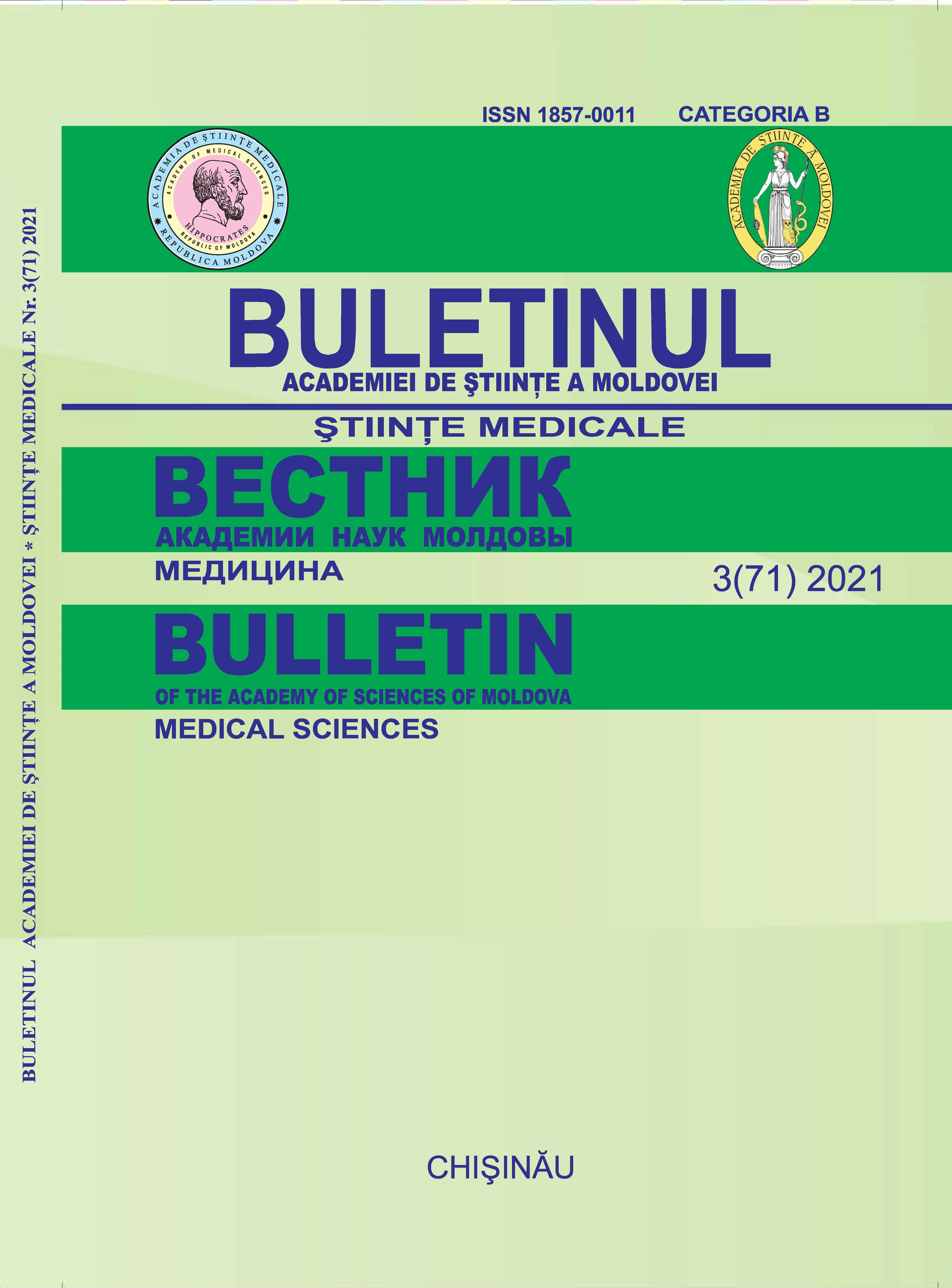Expression of glutation enzymes in splenic tissue is influenced by thiosemicarbazide derivatives
DOI:
https://doi.org/10.52692/1857-0011.2021.3-71.10Keywords:
Schiff bases, coordinating compounds, thiosemicarbazide derivatives, glutathione-dependent enzymes, spleenAbstract
The administration of new Schiff heterocyclic bases and their copper (II) complexes, thiosemicarbazide derivativesinduces various influences on the activity of glutathione-dependent enzymes in splenic tissue. The selective action of thestudied compounds on the expression of glutathione enzymes is evident, which is manifested by a tendency of insignificantdecrease of glutathione reductase (GR) and glutathione peroxidase (GPO), insignificant increase of glutathione-S-transferase(GST) and marked depression of glutaredoxin levels. The slight increase of GST under the action of the studied compoundscan be considered as a protective reaction aimed at stagnating the intensity of peroxide processes and supporting the activityof the glutathione cycle, and decreased the activity of glutaredoxin denotes their antiproliferative, cytostatic effect. Furtherstudies are needed to evaluate the mechanisms of action of the investigated compounds on the activity of glutathione-dependent enzymes in other biosystems and animal experiments, to assess the practical importance of the obtained results.
References
Comhair S.A., Bhathena P.R., Farver C., et al. Extracellular glutathione peroxidase induction in asthmatic lung: Evidence for redox regulation of expression in human airway epithelial cells. FASEB J. 2001; 15: 70–78.
Franco R., Schoneveld O.J., Pappa A., Panaziotidis M.I. The central role of glutathione in the pathophysiology of human diseases. Arch.Physiol.Biochem. 2007;113(4-5):234-58.
Andronache L., Tagadiuc O., Popa V., Gudumac V. Funcţiile biologice ale glutationului. Materialele Conferinţei a XV Ştiinţifice Internaţionale „Bioetica, filosofia şi medicina în strategia de asigurare a securităţii umane”. 2010, p. 252-255.
Gulea A., Poirier D., Ţapcov V., Pahonţu E. Percloraţi de 5-R-Saliciliden-4-feniltiosemicarbazonato(1-)-aquacupru(II) ce posedă proprietăţi de inhibitori ai activităţii enzimei 17α -HSD (Tipul 1). Brevet de invenţie MD Nr. 3996, 2009. BOPI Nr. 12/2009.
Gulea A., Poirier D., Pahonţu E., Ţapcov V., Bejenari N., Roy J. Inhibitori ai leucemiei mieloide umane în baza compuşilor coordinativi ai cuprului(II) cu saliciliden-tiosemicarbazide. Brevet de invenţie MD3890, 2009. BOPI, 2009:4;35.
Tsapkov V., Prisacar V., Buracheva S., Lazakovich D., Gulya A. Synthesis and antimicrobial activity of sulfazine-containing copper(II) coordination compounds with substituted salicylaldehydebenzoylhydrazones. Pharm. Chem. J., 2008,42, 523-526.
Patole J., Padhye S., Moodbidri M. Shirsat N. Antiproliferative activities of iron and platinum conjugates of salicylaldehyde semi-/thiosemicarbazones against C6 glioma cells. European Journal of Medicinal Chemistry 2005,40(10): 1052-1055.
Aggarwal N, Kumar R, Dureja P, Rawat DS. Schiff base as potential fungicides and nitrification inhibitors. J. Agric. Food Chem., 57, 8520-8525 (2009).
Metode de cercetare a metabolismului hepatic. Elaborare metodică / Gudumac V., Rîvneac V., Tagadiuc O., et al. Sub red. Valentin Gudumac; Univ. de Stat de Medicină şi Farmacie „Nicolae Testemiţanu”. – Ch.: S.n., 2012 (Tipogr. „Tehnica-Info”). – 162 p.
Dalle-Donne I., Milzani A., Gagliano N., et al. Molecular mechanisms and potential clinical significance of S-glutathionylation. Antioxid.Redox Signal. 2008;10(3):445-73.
Ghezzi P. Regulation of protein function by glutathionylation. Free Radic Res. 2005, nr. 39, p. 573-580.
Кулинский В. И., Колесниченко Л. С. Система глутатиона. Другие ферменты, тиол-дисульфидный обмен, воспаление и иммунитет, функции. Биомед. химия, 2009;55(4):365-380.
Christy Xavier, Xiaobin Liu, Yang Liu and Hongli Wu. The Important Functions of GSH-Dependent Enzyme Glutaredoxin 2 (Grx2). November 5th 2018. DOI:10.5772/intechopen.78653.
Marta Seco-Cervera, Pilar González-Cabo, Federico V. Pallardó, et al. Thioredoxin and Glutaredoxin Systems as Potential Targets for the Development of New Treatments in Friedreich’s Ataxia.Antioxidants 2020, 9 (12), 1257; doi:10.3390/antiox9121257.
Downloads
Published
Issue
Section
License
Copyright (c) 2022 Bulletin of the Academy of Sciences of Moldova. Medical Sciences

This work is licensed under a Creative Commons Attribution 4.0 International License.



